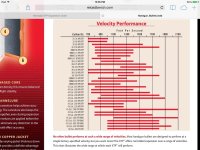STORMINORMAN
Member
From the Hodgdon's site:
Using 110g Hornady XTP with a small pistol primer over approximately 5.2 gr. of either W231 or H-38 for around 1,000 fps. Note: these velocities are from a 7+" barrel.
Not the minimum nor the maximum for these two powders, which according to the manufacturer are identical.
Thanks in advance!
p.s. I'm pretty sure the suggested .357 mag loads for these powders @ 8-9 gr. and 1,500-1,600 fps will expand quite well: I'm looking for something a little milder but still effective to use in a Model 15 2" or a Model 19 2 1/2". Again the stated velocities are from a much longer barrel.
Using 110g Hornady XTP with a small pistol primer over approximately 5.2 gr. of either W231 or H-38 for around 1,000 fps. Note: these velocities are from a 7+" barrel.
Not the minimum nor the maximum for these two powders, which according to the manufacturer are identical.
Thanks in advance!
p.s. I'm pretty sure the suggested .357 mag loads for these powders @ 8-9 gr. and 1,500-1,600 fps will expand quite well: I'm looking for something a little milder but still effective to use in a Model 15 2" or a Model 19 2 1/2". Again the stated velocities are from a much longer barrel.









